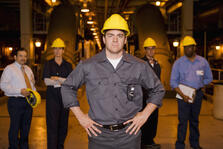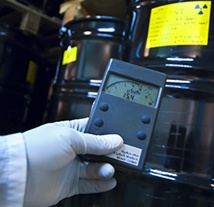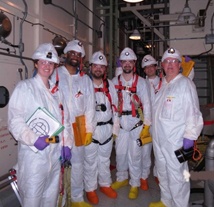by Tim Cullina, Senior Consulting Engineer, Fauske & Associates, LLC
In Part one of this series, "Close Encounters..." I discussed who is the authority having jurisdiction or AHJ. I concluded that there are many AHJs and for discussion purposes, divided them into three kinds of people: permit people, doing business people, and inspectors. (Yes, inspectors are people, too.) I did forget to include a simple statement to the effect of "NFPA is not your AHJ."
 "Getting in bed with the AHJ" has that conspiratorial connotation at the least, and smacks of inappropriate exchanges of, shall we say, favors. That's far from what I suggest with the title. And, thinking of the permit people and inspectors as the "enemy", well, that's just old school. Old school is not a bad thing, but a lot of new learning opportunities have come up since then.
"Getting in bed with the AHJ" has that conspiratorial connotation at the least, and smacks of inappropriate exchanges of, shall we say, favors. That's far from what I suggest with the title. And, thinking of the permit people and inspectors as the "enemy", well, that's just old school. Old school is not a bad thing, but a lot of new learning opportunities have come up since then.
Knowing that there are many potential AHJs with myriad authority is nice. And, knowing what each AHJ can require of you and your enterprise is a necessity. More importantly, understanding what your AHJ knows and what your AHJ can do for your enterprise is equally important. Going back to NFPA 654, we find the AHJs coming into play about 23 times or so, not counting definitions and the annex. What are these AHJs doing?
For the most part, the AHJs are determining, judging, applying and approving "something that you have proposed" as acceptable to [themselves] the authority having jurisdiction.
I would not say they lessen a safety or equipment requirement, but they can approve an acceptable alternative approach to address a hazard, rather than the standard or code-stated requirement also known as the "prescriptive remedy". In a perfect world, the AHJs would be the Solomon-like, risk-referees. They could answer many questions, including: Is this good enough? That is, if you dared to ask.
In the real world they are just like the rest of us, limited by the scope of their knowledge, and not necessarily the experts that will propose a cost-effective remedy. For better (or worse), they are the referees that approve or deny. But all too often, they are not asked.
No one wants to hear, "No." And, you know ...stuff happens. I think that approach may be defended by the old saw, "better to ask forgiveness, than ask permission". But we cannot let that thinking impair safety.
 Asking can be as simple as requesting a variance to a specific code or standard requirement. For more complex alternatives this may entail performing a study or analysis of the hazards beforehand to establish an argument that the alternative is as effective as the prescriptive remedy. This approach, at its simplest level, is called "equivalency". It is also a good "anti-No" strategy. It is in your best interests to work with your AHJ.
Asking can be as simple as requesting a variance to a specific code or standard requirement. For more complex alternatives this may entail performing a study or analysis of the hazards beforehand to establish an argument that the alternative is as effective as the prescriptive remedy. This approach, at its simplest level, is called "equivalency". It is also a good "anti-No" strategy. It is in your best interests to work with your AHJ.
NFPA allows equivalency and states at the beginning of each dust standard that; "Nothing in the standard is intended to prevent the use of systems, methods, or devices of equivalent or superior quality, strength, fire resistance, effectiveness, durability, and safety over those prescribed by this standard." However, this alternate system, method, or device needs to be approved for the intended purpose by the appropriate AHJ. This sounds fair enough, but can it grant authority to AHJs that do not even know they have this added authority, or are not prepared to use it? Then, what do you do?
How do we know what is equivalent? That is a good question and a hard question. Let’s look at the goal of a requirement first. Speaking generally, the goal is to prevent an undesirable and in many cases an unacceptable event, such as a combustible dust explosion. Therefore, we need to understand the science behind hazard. We need to determine the risks, a combination of the severity and frequency of the outcome. And, we need to know how to both prevent and mitigate the event to create options. Of course, you would expect that the alternative will also provide a benefit in either cost or flexibility, or else you would likely go with the prescribed remedy in the first place. What you should not do is nothing.
There is also the performance-based option. It is equivalency on steroids. Here you detail and propose an alternate approach that works (performs) just as well as the prescriptive remedies. It requires, "documented analysis with all calculations, references, assumptions, and sources from which material characteristics and other data have been obtained or on which the designer has relied for some material aspect of the design per Chapter 5 of NFPA 101, Life Safety Code."
So, what really is the difference? I look at it this way. Equivalency can be requested for a minor change of an individual piece of equipment, or to accommodate design or material change, etc. Equivalency opens the door for the performance-based option. But, the performance-based option is more akin to rewriting your own standard so you can end up at the same place, protected.
And, what if your AHJ does not know or understand the appropriate NFPA standard? First verify that you have the correct AHJ. Second, retain firm control of your authority.
Remember, you, the owner or operator, are the most powerful AHJ. Just do the right thing.
Recall again that sage of common sense, Pogo, who said, "We are confronted with insurmountable opportunities". Take advantage of the situation, ask questions. Ask your favorite consultant. Ask the AHJ. Ask Fauske & Associates, LLC (FAI). We employ scientists and engineers engaged in the science of flammability, explosibility, and hazard assessments. Our field engineers have helped clients with combustible dust problems in the Chemical, Pharmaceutical, Agricultural, Energy, and Food industries, as well as a few project less easily defined. They can help you assess your hazards, examine your alternatives, identify equivalences, and help you make your case.
But what if you are the AHJ? Still, ask FAI. Or ask the petitioner of a variance or equivalence to ask FAI. In NFPA 654, Chapter 5, Performance-Based Design Option, Section 5.1.2 Independent Review: "The authority having jurisdiction shall be permitted to obtain an independent third party review of the proposed design."
 Combustible Dust and the Authorities having Jurisdiction (AHJ), Part 3,” based on the Poe tale of a confused and inaccurate account of events that have become public, leading to discussion and disbelief. As a result, the narrator wishes to clear up the facts as well as he can in his own account.
Combustible Dust and the Authorities having Jurisdiction (AHJ), Part 3,” based on the Poe tale of a confused and inaccurate account of events that have become public, leading to discussion and disbelief. As a result, the narrator wishes to clear up the facts as well as he can in his own account.
Yes, indeed, we are confronted with insurmountable opportunities.
Fauske and Associates, LLC, (FAI) can provide to your efforts navigating applicable NFPA, OSHA, and EPA standards. Our experts in Combustible Dust Explosion and Fire Hazard Evaluation, Process Hazard Analysis (PHA), Hazard Identification Risk Analysis, Consequence Analysis, Safer Process Scale-up, Process Safety Program Development, and Relief System Design Review are always here to help. For more information, please contact Jeff Griffin at griffin@fauske.com or 630-887-5278.










